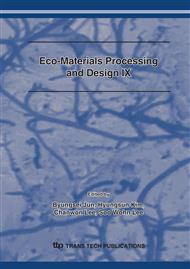p.69
p.73
p.77
p.81
p.85
p.89
p.93
p.97
p.101
Corrosion Resistance of TiAlN/ZrN and TiCrN/ZrN Multilayers during Heat Treatment
Abstract:
Titanium-based nitride coatings on cutting tools, press molds and dies can prolong their life cycle because of superior corrosion and oxidation resistance of coatings. In this study, TiAlN/ZrN and TiCrN/ZrN multilayer coatings were prepared by R.F magnetron sputtering, and microstructural evolution and corrosion resistance of the coatings were investigated during heat treatment. The TiAlN/ZrN and TiCrN/ZrN multilayer coatings were degraded by heating up to 600 oC with formation of oxides particles on the surface. During the heat treatment, the TiCrN/ZrN and TiAlN/ZrN multilayer coatings showed the lowest corrosion current density and the highest polarization resistance at temperature range of 400 oC and 500 oC. Consequently, the TiAlN/ZrN and TiCrN/ZrN multilayer coatings showed good corrosion resistance at temperature range of 400°C and 500°C during heating.
Info:
Periodical:
Pages:
85-88
Citation:
Online since:
January 2008
Authors:
Keywords:
Price:
Сopyright:
© 2008 Trans Tech Publications Ltd. All Rights Reserved
Share:
Citation:


